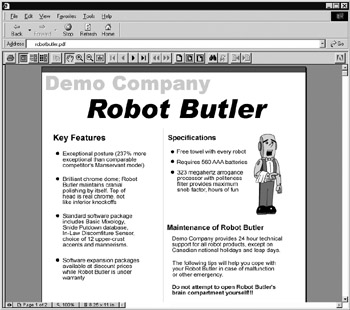PDF Format
| < Day Day Up > |
While so far this chapter has focused on dynamic multimedia such as sound, video, and animation, one more aspect of Web multimedia is worth considering: print. It has long been difficult to get a Web page to print out exactly the way it appears onscreen. Improved browser support of CSS promises greater control in this department, as discussed in the next chapter, but the simple truth of the matter remains that Web pages do not offer the range of layout control available in a print-oriented program like Quark, or even Microsoft Word. And while it is possible to view Word documents in a Web browser, their file size makes them a poor choice for online viewing. Fortunately, Adobe's Acrobat technology offers a viable approach to the online distribution of electronic documentation.
Originally proposed to help implement the mythical ideal of the "paperless office," Acrobat has matured into a product with uses both on and off the Web. Adobe Acrobat provides the capability to deliver an electronic document to an end user without requiring the reader to have the authoring environment to open the file. Visually, Acrobat preserves the exact look and feel of the document, both onscreen and in print. For design-oriented Web publishers, Acrobat provides a highly motivating presentation alternative that easily surpasses HTML's relatively simplistic and imprecise layout features, as shown in Figure 9-3.

Figure 9-3: Sample Acrobat document
Acrobat files are created by using a combination of traditional text authoring tools (word processors and desktop publishing software) and special Acrobat authoring software (Adobe Exchange or Distiller). The files are then saved in a file format aptly named Portable Document Format (PDF). PDF files are small, self-contained documents that can be transported in a variety of ways: via diskette, CD-ROM, or network. The end user then reads the files by using special Adobe Acrobat Reader software. Thus, by its very nature, Acrobat reader technology must be cross-platform. Versions of the Acrobat Reader software are currently available for the following operating systems: Microsoft Windows variants; Macintosh OS; Linux; Sun Microsystems' Sun SPARC Solaris and SunOS; Hewlett-Packard's HP-UX; Silicon Graphic's IRIX; IBM's AIX and OS/2; and Digital's VMS.
Inserting an Acrobat file in a Web page is as simple as linking to the document with the <a> tag. For example,
<a href="document.pdf"> Demo Company Data sheet (Acrobat PDF Format, 55Kb) </a>
If a PDF is used, make sure to let users know what it is with an appropriately named link or PDF icon. It is a good idea to indicate the file size of a linked PDF. It might also be useful to the user to know the last time the document was modified. Lastly, make sure to provide information on where to obtain the Acrobat reader for users who may not have it. All these ideas are illustrated here.

For more information about Acrobat and more details on how Acrobat might be included in a Web page, visit Adobe's Web site at www.adobe.com/acrobat.
| < Day Day Up > |
EAN: 2147483647
Pages: 252